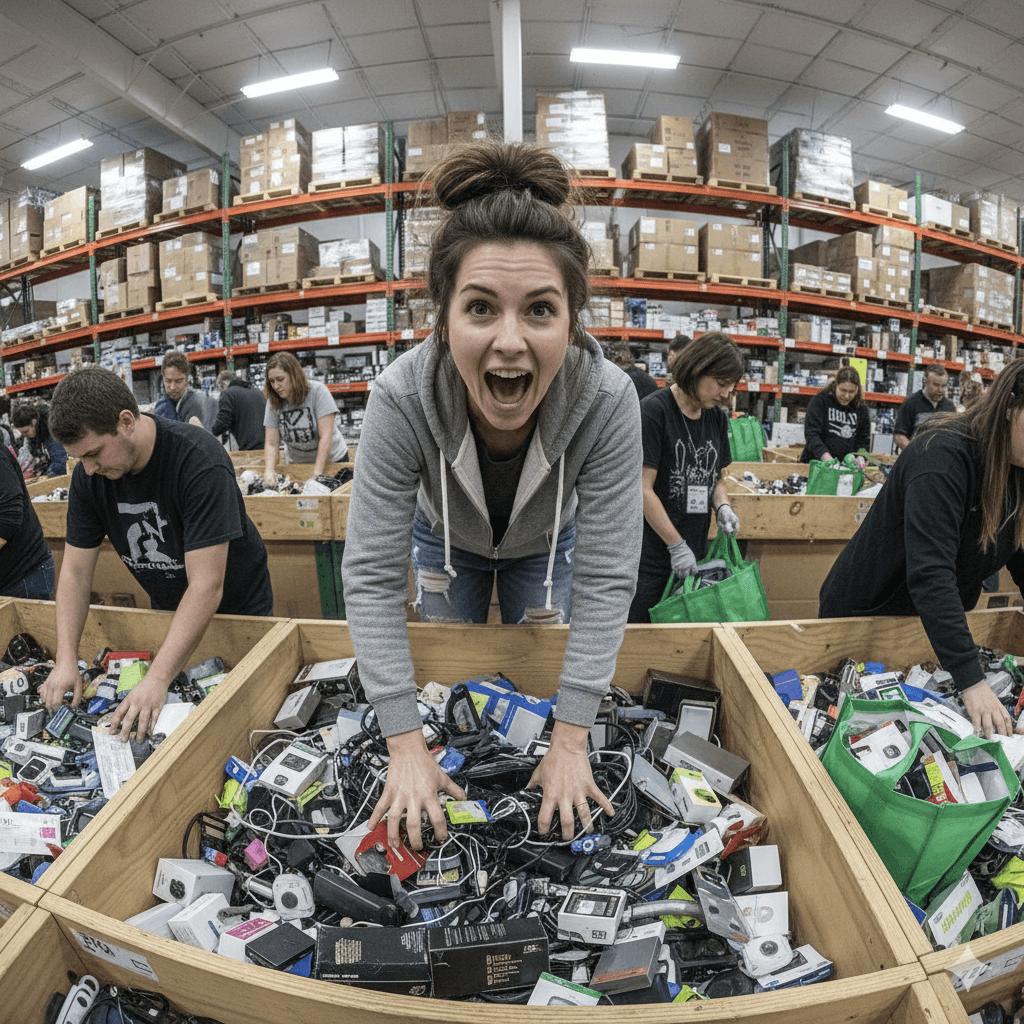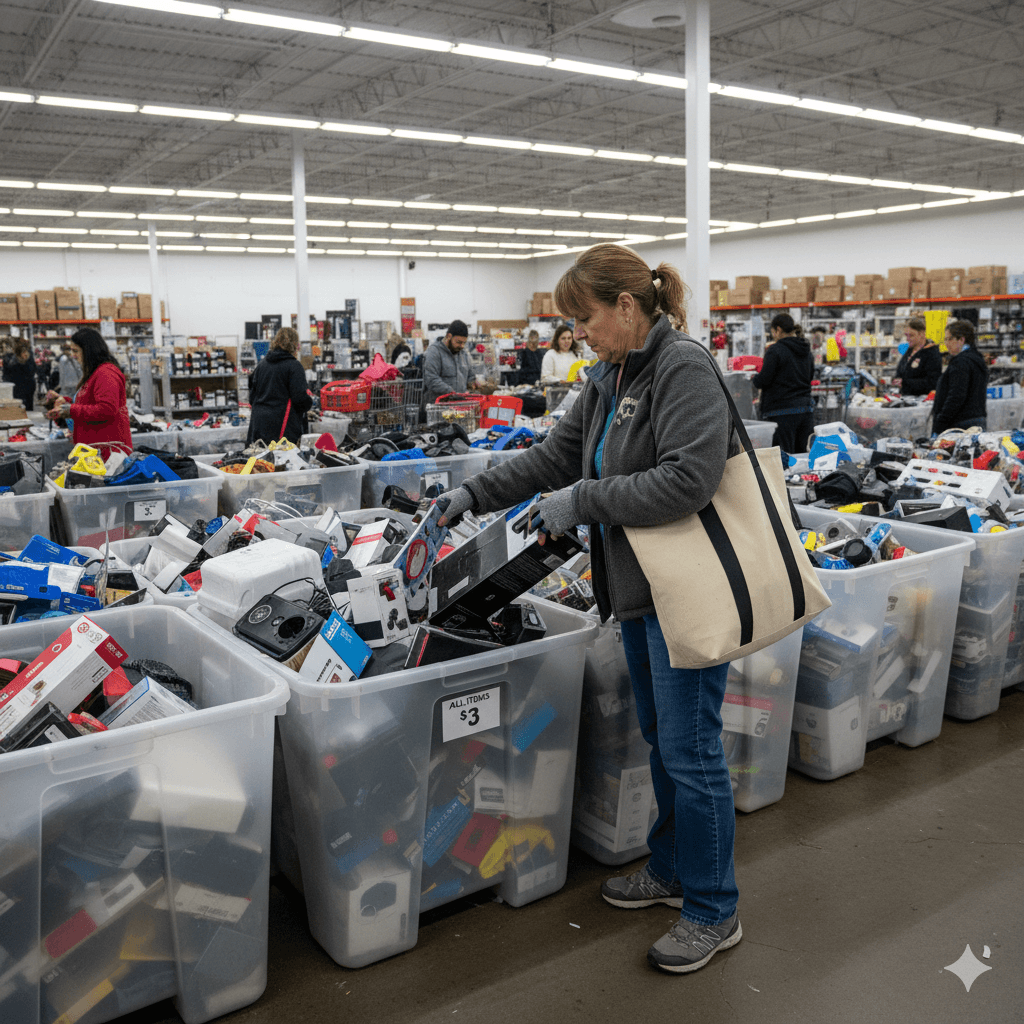Intro
For the uninitiated, the moment a fresh set of liquidation bins rolls onto the floor—the "Bin Drop"—looks like pure, unadulterated madness. Shoppers, armed with gloves and laser focus, descend into a frenzy, tearing through boxes, tossing aside perceived trash, and shouting over one another.
This isn't just random chaos; it’s a high-stakes moment driven by powerful psychological forces. Understanding these forces and knowing how to control your own behavior during the adrenaline rush is the secret weapon that separates the casual shopper from the high-profit reseller.
This article dives into the psychology of the bin drop, offering strategies to turn mass hysteria into your competitive advantage and consistently maximize your haul.
The Behavioral Economics of Scarcity
The entire bin store model is built on two core behavioral drivers: Scarcity and the Variable Reward Schedule.
A. The Power of Perceived Scarcity
When the bins are new, the items are the most expensive, yet the crowds are the biggest. Why? Because the supply of high-quality, high-value items is at its absolute peak. Shoppers instinctively know that if they don't grab that name-brand item *right now*, someone else will.
- The Competitive Urge: The visible competition—seeing other shoppers securing large, profitable boxes—triggers an innate "fear of missing out" (FOMO). This drives impulse buying, often leading shoppers to grab items they haven't properly vetted (a mistake you should avoid, as detailed below).
- Your Strategy: Calculated Focus: Instead of letting FOMO dictate your actions, use the perceived scarcity as a filter. Focus your initial search only on items that fit your pre-researched, high-profit niches. Everyone is scrambling for a visible TV box; maybe you should quietly search the apparel bin for a high-end designer tag that everyone else misses.
B. The Thrill of the Variable Reward Schedule
Bin shopping is gamified. You don't know if the next item you touch will be a piece of junk or a brand-new, valuable drone. This "maybe it’s a winner" uncertainty is the same psychological loop that drives gambling and video game addiction.
- The Dopamine Hit: Finding a great item, even a small one, releases a hit of dopamine, encouraging the shopper to keep digging, regardless of fatigue or disappointment.
- Your Strategy: Ride the Wave, but Keep Score: Embrace the excitement—it’s part of the fun!—but don't let it cloud your judgment. For every item you put in your cart, remind yourself of its estimated resale value. This keeps the transaction transactional, not emotional.
Mastering the Bin Drop: 5 Psychological Tactics
The most profitable diggers don't just dig harder; they dig smarter by controlling the psychological environment.
1. The Power of Peripheral Vision and The Anchor Strategy
During the initial rush, everyone is looking down, focused on the immediate three feet in front of them. The pros use their peripheral vision.
- Anchor Your Spot: Find a corner or end-point of a bin you want to target. This is your "anchor." People are less likely to crowd you aggressively if you are firmly stationed in a clearly defined space.
- Scan the Horizon: While your hands are busy sifting, your eyes should be scanning the surface of adjacent bins and carts that others are tossing items from. Many high-value goods are quickly discarded by less-informed shoppers who mistake them for trash (e.g., mislabeled wires, specialized tools). One person's "trash" is your treasure.
2. The Psychology of the Toss-Back
A huge secret of bin shopping is that the best deals are often those items that other shoppers have already rejected.
- The Error Rate: When the adrenaline is pumping, shoppers move fast and make mistakes. They discard items because they don't recognize the brand, assume it's broken, or simply want to lighten their cart load.
- The Follow-Up Strategy: Wait 15 minutes after the initial drop. Go through the items that have been tossed onto the floor or placed back onto the top of the bins. They have already been touched by human hands, meaning they were deemed worthy of inspection, even if later rejected. This simple technique can yield brand-new, profitable items without having to fight the initial crowd.
3. Avoiding the Sunk Cost Fallacy at the Sorting Station
The "Sunk Cost Fallacy" is the error of continuing an endeavor because of resources already invested. In bin shopping, this means keeping a broken item in your cart because you spent time finding it.
- The Sorting Ritual: The sorting break is mandatory. When you sort, be ruthless. The cost of carrying, testing, storing, and eventually disposing of a non-profitable item is higher than the five minutes you spent digging for it.
- Focus on the Future: Ask, "If I saw this item right now, would I spend the money and time to acquire it?" If the answer is no, put it back neatly (don't toss it!) and move on.
4. The Unspoken Rules of Bin Etiquette (De-escalation)
While it seems like a free-for-all, there is an unwritten code among serious bin shoppers. Understanding and adhering to this code helps de-escalate tension and maintain focus.
- The Zone of Influence: Respect the space around a stationary shopper. You wouldn't reach directly over someone at a grocery store, so don't do it at the bin store.
- Helpful vs. Competitive: If you see a shopper looking for a specific item, and you spot it, hand it to them. This creates a positive, collaborative energy that reduces friction, and often, others will return the favor.
- Control Your Cart: A runaway cart is the enemy of everyone. Keep your haul close and covered. Respect for the shared space is key to a smooth shopping experience.
5. Leveraging the Drop-Day Exhaustion
The first drop of the day is often the most profitable, but many customers are mentally and physically exhausted by the time the second or third rotation occurs.
- The Late-Day Profit Window: If you can stay energized and focused later in the day, the crowds thin out, and the quality of items that slip through and make it to the later bins often remains high. The third and fourth drops can be a goldmine simply because your competition has gone home.
- Recharge: Take a 15-minute break in your car or the break area. Rehydrate, eat a small snack, and review your notes. You'll return sharper than those who have been digging continuously for five hours.
Your Next Psychological Advantage
The liquidation store environment is designed to reward the prepared. By understanding the psychological triggers—the adrenaline, the scarcity, and the variable rewards—you can control your impulses and make objective, profit-driven decisions.
Ready to put this knowledge to the test?
Start by finding the highest-volume bin stores in your region so you can practice on the busiest days. Use the search function on the https://www.findaliquidationstore.com/ homepage to locate the hottest liquidation stores and outlets near you and gain your competitive edge.
Find your nearest high-traffic liquidation bin store using the search function on our homepage at https://www.findaliquidationstore.com/ and start practicing these tactics.



